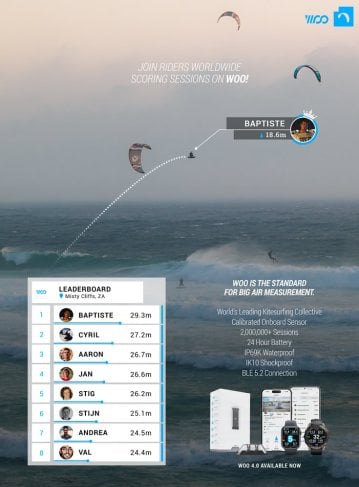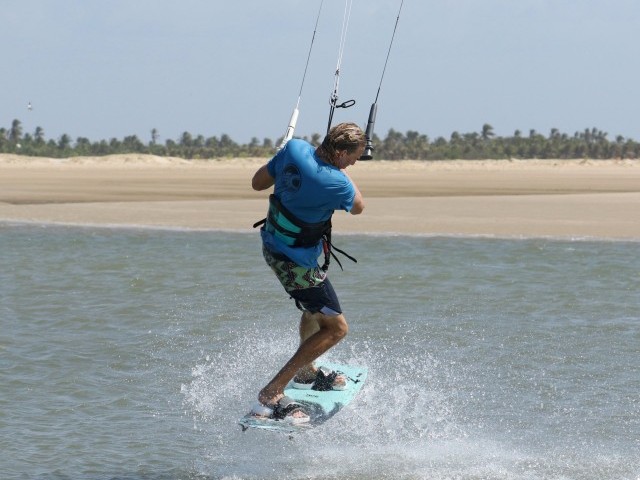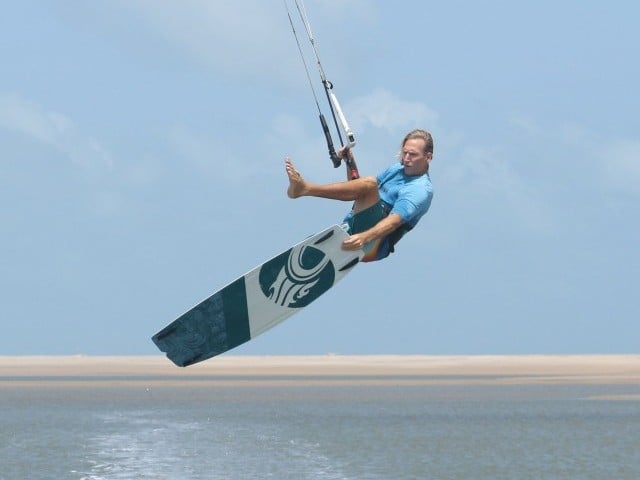
Board Behind Front Loop Waterstart
Technique / Intermediate
We often encourage new moves as variations, but if the truth be told they are merely building blocks upon a solid foundation. The old adage holds true; you have to earn the right to progress. This can be viewed as a negative motivation. However you see it, the candid fact is, that without the base you can’t build. Fortunately for us in kiting even the base is fun. A few issues back we took you through the board behind water start. Now it’s time to progress, adding a front rotation.
As is oft our manner, let us suggest that as well as the base move you should also be comfortable with front loops/rolls. It will also be wise to attempt this on your preferred front rotation side, as both the rotation and landing will feel more instinctive. So how does it work? In the following Christian is intending to land riding to his right, so kite movement will be left to right….
The Prep Pic A.
Having fluffed yet another trick, Christian finds himself in the somewhat familiar position of dragging through the water with his board behind him. Salvation is close though, as he holds the joker in his hand and can, therefore, reclaim his pride.
First things first, he needs to get the kite under control and in the right position. As he wants to jump to the right, he slowly brings the kite around the window down left towards 10:30 or 11 o'clock. Power/wind strength will dictate how far down you need to move it, the less power you have, the lower you’ll need the kite.
Christian moves it slowly so that it doesn’t pull him if it does he will lose tension and not get enough lift when he sends the kite forwards. With the kite parked where he wants it, Christian gets the bar on the sweet spot so that the kite will react as quickly as it can.
Don’t, however, pull the bar past the sweet spot as then you won’t get the lift when you want to start, but will instead get pulled downwind as the kite stalls. Theoretically, you should be pretty au fait with this if you’ve been practising the Board Behind Waterstart version 1.0.
The Send Pic B.
Once the kite is back where you want it, you can then send it forward with more meaning. You can see that Christian has been quite positive with his bar, as he’s trying to move the kite quickly and he keeps the bar on the sweet spot as he doesn’t want the kite to stall or depower.
However, he hasn’t yanked down on the front hand as he wants the kite to go up to 12 o’clock, not cut off the top of the window. He’s watching it like a hawk to make sure that it turns fast BUT goes up over 12 rather than overdoing it, chopping the window and diving it down. 12 is again your magic number.
With the kite going up, over and past 12 the kite is already lifting Christian, so his upper body raises out of the water. If the kite starts to lift you too early, before it gets to 12 o’clock, you can let the bar out slightly and time your moment.
Lift & Roll Pic C.
With the kite moving overhead Christian pulls down a fraction on the bar for extra lift. The chances are that this will stall the kite a bit, so the pull will be both upwards and downwind. Now comes the true variation as you add your front rotation.
There are a couple of things to consider. You need resistance from your board to make sure that you get lifted, as you need height and time to complete your rotation. And of course, you need to get the rotation going. The good news is that your rotation will bury the board’s nose in the water, so resistance is guaranteed.
Rotation wise, you can’t kick off your back leg against your edge, so instead, you must focus your energy on the upper half of your body. As soon as you pull the bar in throw your head and shoulders forwards, simultaneously turning them back. This movement needs to be aggressive and to be honest quite forced.
You can see that as Christian throws his upper body forwards and down, his head shoulders and waist are working together, which gives the movement more power. If your head and shoulders turn separately, you won’t get as much rotation. Finally spare a thought for your kite. You should have the lift you wanted, as such you don’t want to do much else. Concentrate on keeping the kite still above you, don’t pull heavily on your front hand as you rotate!
Headworks Pic D.
This part of the move demonstrates why you should be trying this on your preferred side, benefiting from your natural ability to land. Looking at the pic, you can see that Christian is stretched out, almost upside down and facing the wrong way. As such he won’t have many familiar cues to guide him through to landing.
Your objectives here are to keep the kite above you and get around your rotation. With the nose of the board digging in and tripping you up, the rest of the rotation is all about throwing you head around aggressively so that once the board releases it will follow you, so really look over your shoulder and try to spot your landing – much like an S-Bend!!!
Back to Christian in the picture. You can see how he’s straining to get his head around. Once he does, he’ll get his bearing, and all will be tickety-boo. He has a small amount of pressure on his front (right) hand as he wants the kite moving with him, but nothing too aggressive, as it must stay high.
Follow the Leader Pic E.
This is a good moment. You can see that once the board releases it springs forwards and follows Christian’s lead. His hips are coming around, his knees are following, and the board is suddenly halfway around its rotation. Realistically once you get to here, you’re fine, so long as you have enough height and time, which all comes from your initial water start, kite positioning, and send. You will undoubtedly be moving downwind, but as long as your kite went up over 12 o’clock and didn’t stall too much, you’ll also have taken flight. If, however you find yourself too low to land, at least you can celebrate your rotation.
Undercarriage Down Pic F.
Gravity always wins, and in this case, it’s your friend. You’re attached to the kite, the kite is highish in the window, and thus you’re lifted and for want of a better word, floating. However, your legs and board which are dangling will give in to that 1g, and therefore swing down underneath you, ready and waiting for your imminent return to earth. All that’s left is to concentrate on the usual landing sequence – getting the board downwind and diving the kite for a smooth tail first touchdown. Christian’s legs have miraculously swung down, and he’s given the kite a decent dive to pull him out of the move.
Top Tips
The usual baby steps apply. It makes perfect sense to perform a couple of “bog standard” board behind water starts first. This way you’ll get a feel for the power in the kite, the positions needed, the send required and the relevant sweet spot. Once you’re lifting without incident, it’s time to add the front rotation. Do exactly as before but add the upper body throw and you’ll be most of the way there if not all the way around.
It goes without saying that you should make sure that the water is deep enough and free from obstructions and other kiters as you can get disorientated the first few attempts.
Have a look through the videos and the sequence to get an idea of the full shebang.
Common Problems
The most likely problem is not getting enough lift. If this is the case, take the kite back further before sending it up and over, but don’t send it any harder as you don’t want it flying too far forwards.
If you’re not getting any rotation, you may be waiting too long. As soon as the kite lifts you need to throw the head and shoulders, so that they work against the resistance the board creates.
If you’re getting the rotation but don’t get all the way around. You need more lift, so see above.
If you’re getting around but struggling to land as you’re coming in hot, the chances are that you’re giving it too much of an initial send. Be less aggressive with the kite, so that you don’t travel as far downwind and as fast. Also, make sure that you’re not stalling the kite by pulling the bar too far in. If you tend to do this, trim the bar so that you can’t stall the kite as much, even if you pull all the way.
Keystones
- Move the kite slowly back towards 11 or 1
- Turn the bar aggressively to move the kite quickly up towards 12.
- Pull the bar in, level it and throw your head and shoulders forwards and down
- Once clear really look over your shoulder to spot the water.
- As legs follow and drop, dive the kite and point downwind
This technique article was in Issue 65 of IKSURFMAG.
Related
By Christian and Karine
Christian and Karine have been working together as a coaching team, running improver to advanced kitesurfing clinics since 2003.































